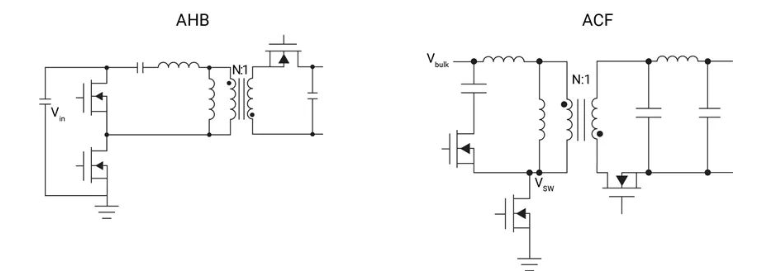
Consumers expect a variety of electronic devices to be equipped with portable, fast and efficient chargers. With most electronics moving to USB Type-C® chargers, more and more users want to be able to charge all their devices with a compact power adapter.
When designing modern consumer-grade USB Type-C mobile chargers, PC power supplies, and TV power supplies, the challenge is how to maintain or even increase power levels while shrinking the size of the solution. Texas Instruments' low-power gallium nitride (GaN) devices help solve this problem in a variety of the most popular topologies, while providing heat dissipation, size, and integration benefits. Over the past few decades, with the development of wide-band gap technologies such as GaN, there have also been new improvements in AC/DC topologies aimed at improving efficiency and functionality. This article will delve into the advantages and compatibility of these devices in popular topologies for such applications, as well as some exciting new topologies.
Maximize efficiency and power density with ACF and AHB topologies
Some newly developed half-bridge topologies can optimize efficiency while providing variable output voltage capability. The active clamp flyback (ACF) topology and asymmetric half-bridge (AHB) topology shown in Figure 1 help to maximize the efficiency and power density of the DC/DC stage. Instead of using lossy buffer clamping like quasi-resonant (QR) flyback topologies or zero-voltage switching (ZVS) flyback topologies, ACF and AHB topologies are able to recover the leakage energy back to the output, so efficiency can be further improved. Both topologies are also able to completely eliminate voltage spikes on the low-side field-effect transistor (FET), enabling a low-voltage synchronous rectifier FET on the secondary side. In addition, the AHB topology does not require a second output filter, so the overall solution is less costly and smaller.
Figure 1: ACF and AHB topology

The LMG3624 integrated GaN FETs feature integrated "non-destructive" current detection to help further increase efficiency by reducing power losses, as shown in Figure 2. For example, in the 65W ACF, the loss of integrated current detection is less than 10mW, while the loss of traditional current detection schemes is about 170mW. Any topology that requires current mode control (including ACF, AHB, etc.) will greatly benefit from this dramatically reduced loss and enable a more efficient overall solution.
Figure 2: Power loss comparison between integrated current detection and conventional current detection

The Totem pole PFC topology supports higher power designs
In most cases, once the power level reaches more than 70W, a power factor correction (PFC) stage is required. At the PFC level, if you want to take advantage of the capabilities of Gans, you need to consider the totem pole PFC topology, as shown in Figure 3. With the bridge rectifier removed, the value of GaN FETs in this topology is enhanced due to zero reverse recovery loss.
Metal-oxide-semiconductor field-effect transistors (MOSFETs) have body diodes that produce a high reverse recovery charge, while silicon carbide (SiC) has little improvement in reverse recovery charge, so MOSFETs are almost impossible to use in this topology. On the other hand, the LMG3624 provides an adjustable piezoswing rate that helps to find the right balance between electromagnetic interference and efficiency in the system.
Figure 3: Totem pole PFC topology

QR, ZVS, LLC, and low-power GAns in boost PFC topologies
Although new topologies have begun to gain traction, there are still clear advantages to using integrated Gans in conjunction with traditional topologies. GaN is becoming more common in QR flyback topologies, ZVS flyback topologies, and traditional boost PFC topologies, as you can see improvements in efficiency and switching frequency capability by simply replacing a single switching FET with a GaN FET (mainly due to the lower input capacitance of GaN, which reduces the turn-off loss). In addition, the LMG3624 GaN FET has a low static current, and its standby mode can further reduce the static current. QR, ZVS and boost PFC topologies also benefit from the integrated non-destructive current detection capabilities in the LMG3624.
The LLC resonant converter topology has been around for decades and is popular in fixed-output voltage applications such as laptop adapters and TV power supplies, where USB Type-C controllers are not yet universally available to provide output voltage. The LLC topology will also achieve higher transformer efficiency than most half-bridge DC/DC topologies.
Conclusion
With the growing demand for smaller, more efficient AC/DC solutions, consumers prefer smaller adapters that are more portable. In the industrial environment, with the increasing power requirements of graphics processing units, the need for high efficiency power supply units (Psus) is becoming more and more urgent. The thinner PSU also paves the way for slimmer, high-end TVS. The LMG3624 offers features and benefits that can be integrated into all the topologies described here, and its versatility helps meet the requirements of these applications.
About US
Heisener Electronic is a famous international One Stop Purchasing Service Provider of Electronic Components. Based on the concept of Customer-orientation and Innovation, a good process control system, professional management team, advanced inventory management technology, we can provide one-stop electronic component supporting services that Heisener is the preferred partner for all the enterprises and research institutions.
